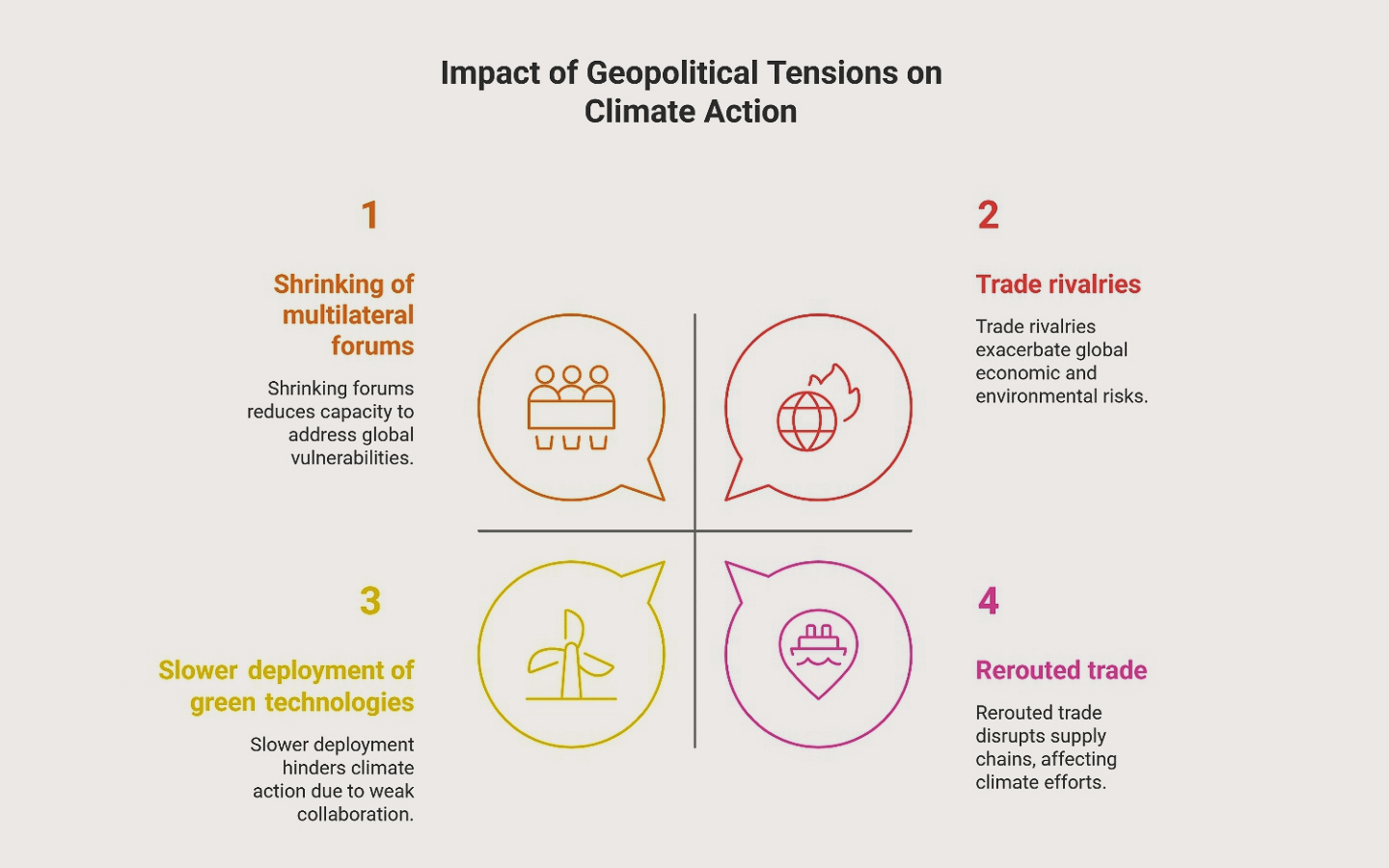by Dr Syed Yaqzan
Caught in the Crossfire: Can Climate Action Survive Rising Geopolitical Tensions?

World Environment Day 2025 arrives at a time when the world feels anything but united; the ripple effects of geopolitical tensions and conflicts are felt across politics, society, and the environment. The planet is heating, glaciers are melting, and carbon levels are rising steadily. Yet headlines are dominated by soaring defence budgets, contested airspace, and the weaponisation of global trade routes, highlighting the growing fragility of the supply systems that connect us. In the face of multiple global conflicts and strategic rivalries, nations are increasingly consumed by short-term calculations of power and positioning.
This year, we are witnessing a decisive shift: major geopolitical events are influencing global emissions trajectories. Trade corridors are being leveraged as instruments of influence, exposing the fragility of global supply chains. These geopolitical pressures are increasingly sidelining sustainability imperatives in favour of strategic advantage. As diplomatic standoffs escalate, sustainability strategies are being delayed, deprioritized, or displaced altogether. And that is a risk the world cannot afford.
Climate Action in a Complex World
Geopolitical tensions do not merely create momentary uncertainty, they produce a cascade of disruptions that directly and indirectly undermine climate action. This impact can be best understood across four interrelated areas, as illustrated in the visual model “Impact of Geopolitical Tensions on Climate Action.”

First, as multilateral forums shrink, global capacity for coordinated climate action declines. Diplomatic stand-offs, polarisation, and nationalist agendas have eroded trust in institutions like COP, weakening the very platforms designed to enable shared solutions. When countries retreat from these spaces, climate goals lose the coordination they require to succeed. Second, rising trade rivalries have begun to fracture logistics infrastructure and introduce systemic delays. As nations impose trade barriers and retaliatory tariffs, cross-border movement of goods becomes less predictable. This unpredictability not only disrupts supply chains but also discourages investments in sustainable transport systems and joint decarbonisation initiatives. Third, the deployment of green technologies is stalling. Not due to scientific or technical limitations, but because geopolitical instability has compromised the foundations of trust and cooperation. Clean tech development relies on consistent policy frameworks, open markets, and regulatory alignment, each of which is eroded by global friction.
Finally, conflict-rerouted trade itself is accelerating emissions. As vessels avoid key passages like the Red Sea or Suez Canal due to conflict, detours raise emissions, delay goods, and disrupt sustainability-linked targets. In this fractured system, emissions rise, not from a lack of knowledge, but from an inability to act collectively. Taken together, these four disruptions do not just delay progress; they lock the global climate agenda in a dangerous loop. As tensions rise, forums shrink, innovation stalls, and emissions climb. This creates environmental and economic vulnerabilities that in turn fuel more instability, closing a self-reinforcing loop of strategic and ecological risk. If we fail to break this loop, we risk turning climate inaction into the next cause of geopolitical disruption.
Climate Change as a Driver of Conflict Itself
Ironically, while geopolitical tensions are currently derailing climate progress, climate change itself is poised to become a major driver of future conflicts. Water scarcity could inflame dormant disputes over shared rivers. Sea-level rise may displace millions, putting pressure on already strained borders. Food insecurity, fueled by heatwaves, drought, and crop failure, could destabilize fragile economies. When disasters strike, competition for insurance, aid, and recovery resources can easily escalate into conflict. Climate change is no longer just a policy challenge, it is becoming a geopolitical accelerator. If we fail to act now, we are not only risking environmental catastrophe, but also sowing the seeds of political and economic instability. The very international order we are seeking to protect through maneuvering and militarization may be most at risk from the environmental crises we continue to neglect.
The Role of Organisational Leadership
In this leadership vacuum, it falls on organisations, corporations, universities and non-profits, to chart the course forward. These entities are not bound by the same strategic gridlock that hinders governments. They can act faster, set ambitious goals, and build coalitions to accelerate climate progress. Leadership starts with action: decarbonising supply chains, embedding sustainability into procurement, and adopting clean technologies. But it doesn’t stop there. It involves reshaping internal priorities and external partnerships around long-term environmental resilience.
Organisations can also foster cooperation where diplomacy fails. Public-private partnerships, industry coalitions, and cross-sector initiatives can become engines of innovation and momentum. Academic institutions can offer data and solutions, while civil society pushes for equity and accountability. In the face of fragmentation, leadership is not about control, it’s about coherence. Institutions that act with moral clarity and strategic foresight can turn sustainability into a stabilising force. They can demonstrate that environmental integrity and strategic strength are not in conflict, but mutually reinforcing.
From Chaos to Harmony: A Strategic Reframe
Numerous regional flashpoints have exposed the fragility of a system that once promised seamless global exchange. Short-term responses like price controls and route diversions may buy time, but they do not address the deeper vulnerability of our systems. Yet even amid this chaos, there is opportunity. Geopolitical tension need not spell climate retreat. With bold thinking and institutional courage, this crisis can serve as a pivot point. Climate goal can become a diplomatic tool, an economic engine, and a peacebuilding platform. The future demands not just new technologies, but new mindsets. In an interconnected world, fragmented responses will always fall short.
Multilateralism, equity, and ecological balance must be restored as pillars of global stability. If we succeed, World Environment Day 2025 will not mark another year lost to conflict, it will stand as a turning point toward harmony, security, and shared climate progress. If the world can act boldly now, sustainability will no longer be a casualty of global conflict, it will be its antidote.







